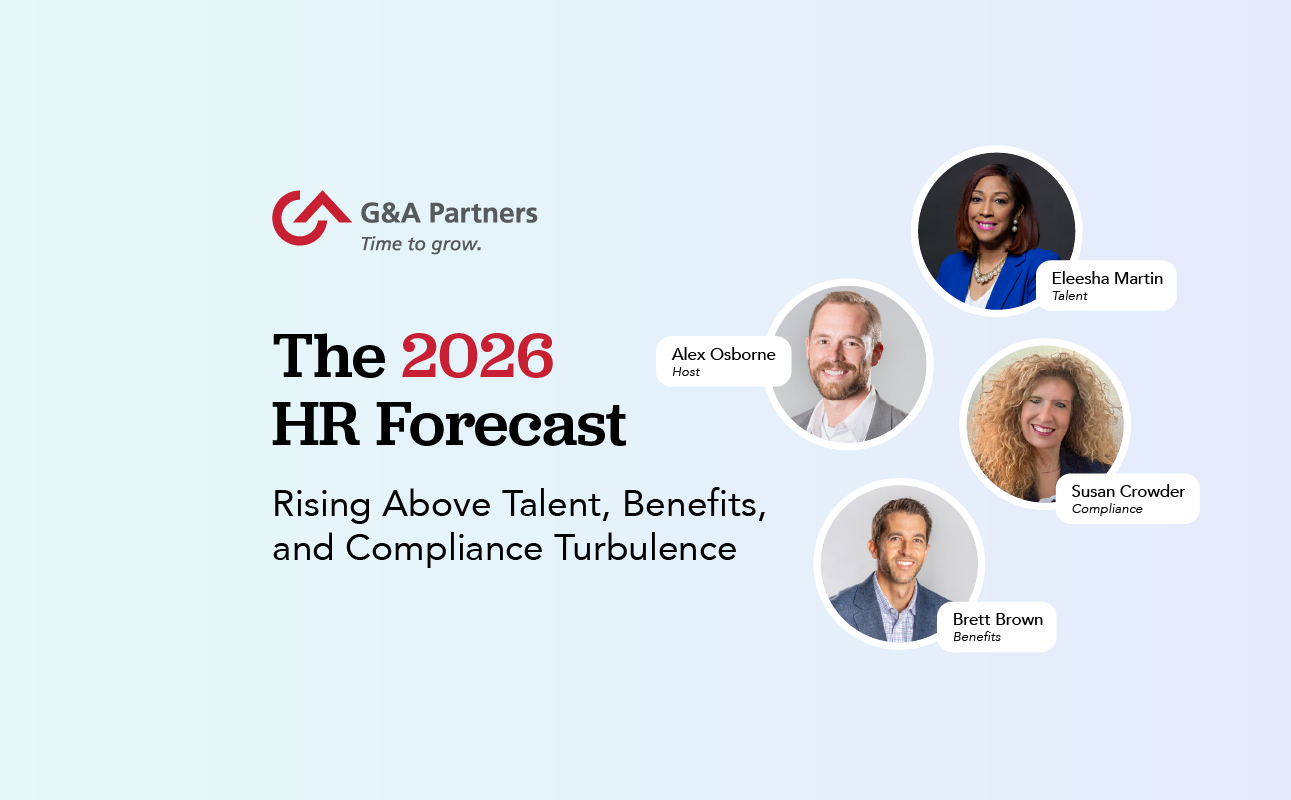
In this article, we'll explore:
Stay ahead with expert insights.

From compliance deadlines and budget discussions to payroll wrap-ups, benefits renewals, and workforce planning—the lead up to year end is one of the busiest and most important times of the year for business owners and HR teams.
For small and mid-sized companies, however, the volume and breadth of these processes—often carried out by just a few team members—can challenge even the most efficient groups.
A structured HR year-end checklist offers peace of mind amid the rush. It helps you manage competing priorities, stay compliant, and start the new year organized and ready to move forward.
In the sections that follow, we’ll walk through 10 essential steps to include in your human resources checklist—so you can close out the year with confidence and position your business for success in 2026.
1. Review Employee Records and Update Files
A good first step for your end-of-year HR checklist is to ensure all employee information is accurate and complete. Up-to-date employee data helps you prevent delays in tax reporting, reduce payroll errors, and start the new year on solid footing.
Here’s what to focus on:
- Confirm employee details: Verify that each employee’s address, phone number, emergency contact, and tax forms are current. The address is particularly important since it determines where W-2s will be mailed in January.
- Ask employees to review their information: Send a companywide reminder before year-end, with a clear deadline for employees to check and confirm (or update) their current information.
- Ensure secure recordkeeping: Store sensitive documents, such as I-9s, W-4s, and direct deposit authorizations, securely within your HR system or a platform that limits access to authorized personnel.
2. Verify Payroll and Tax Compliance
Year-end payroll and tax reconciliation require careful attention to detail. Even small errors in wages, tax withholdings, or reporting can lead to penalties, frustrated employees, and compliance issues.
Take these steps to ensure your year-end payroll process runs smoothly:
- Check final payroll runs: Review each pay period for missed hours, bonuses, or adjustments to ensure your last payroll is complete and accurate.
- Prepare year-end tax forms: Verify that employee and contractor information aligns with W-2 and 1099-NEC requirements and confirm the filing deadlines. Keep in mind that these forms should be filed in January, after the final payroll runs.
- Reconcile deductions: Confirm that benefits contributions, garnishments, and tax withholdings are correct and match employee selections.
- Plan for compliance in the year ahead: Identify any new or changing federal, state, or local tax obligations that will take effect in the coming year.
With multiple deadlines and regulations, accurate payroll management is one of the most important and time-sensitive tasks on any year-end HR checklist. Partnering with a PEO can help streamline year-end payroll processing—ensuring timely and accurate filings that minimize errors, penalties, and administrative stress.
3. Review Benefits and Open Enrollment Data
For some businesses, year-end coincides with open enrollment season, making benefits management a critical priority on your HR checklist. This is the ideal time to review and confirm elections, update contribution amounts, and ensure compliance with Affordable Care Act (ACA) regulations.
Take these steps to stay organized:
- Audit benefits enrollments: If your open enrollment period recently closed, verify that employee elections and dependent information were processed correctly.
- Reconcile payroll deductions: Confirm that contribution amounts in payroll match employee benefits selections for medical, dental, vision, and retirement plans.
- Update benefits provider data: Communicate any changes in coverage or contributions to carriers to avoid lapses or overpayments.
- Prepare for ACA reporting: If your company qualifies as an applicable large employer (ALE), start gathering and preparing data for 1094-C and 1095-C forms.
A PEO partner can simplify this process by centralizing benefits administration, coordinating with carriers, and supporting ACA reporting, allowing your HR team to focus on people and planning rather than paperwork.
4. Review PTO Balances and Carryover Policies
Time-off management is one of the most important—and often most overlooked—areas of year-end planning. Reviewing paid time off (PTO) balances and carryover rules helps you avoid confusion, ensure compliance, and maintain employee satisfaction.
To stay proactive:
- Review your policy: Determine whether unused vacation and leave balances will reset, carry over, or be paid out at year-end. Not all companies follow the same approach, so confirm your plan and prepare to execute it consistently.
- Communicate deadlines: Notify employees 4–6 weeks before cutoff dates so they can schedule remaining time off. Clear communication helps prevent an influx of last-minute leave requests.
- Ensure compliance: Confirm your PTO policy aligns with current federal, state, or local laws and regulations— especially if you operate in states with paid leave or paid sick leave requirements.
- Assess policy effectiveness: Evaluate whether your current PTO policy supports both work-life balance and operational needs. If updates are needed, consider updates and prepare to communicate changes before the start of the new year.
A PEO can streamline this process by providing time tracking and payroll technology that automates accrual tracking, usage, and carryover calculations, eliminating manual errors and ensuring compliance with evolving paid leave laws.
5. Conduct Performance Reviews and Set Goals
Year-end is an opportunity to reflect on employee performance and set the stage for growth in the year ahead. Performance reviews help strengthen engagement, align individual goals with your company’s broader objectives, and give employees insight into the impact their hard work has on the organization’s overall success. They are a key part of any comprehensive human resources checklist.
Here’s how to effectively wrap up evaluations:
- Complete outstanding reviews: Ensure all performance discussions are documented and linked to compensation or development plans.
- Connect outcomes to career growth: Use review results to inform promotions, raises, and professional development opportunities.
- Reinforce company culture: Regular performance conversations foster accountability, clarify expectations, and encourage continuous improvement.
- Set clear goals for next year: Establish measurable objectives for each department and employee to align with business priorities.
A PEO can support your business by providing performance management tools and expert HR guidance to ensure your review process is consistent, fair, and compliant with labor laws.

6. Evaluate Employee Classification and Compliance
Misclassifying employees is one of the most common—and costly—compliance mistakes businesses make. Classification determines overtime and minimum wage protections, which benefits employees receive, and what taxes must be withheld. Reviewing classifications is an important part of an HR year-end checklist, and doing so can help you avoid penalties, audits, and employee disputes.
To stay compliant:
- Review employee classifications: Reassess each role to confirm whether workers are properly classified as employees or independent contractors. Review factors such as the level of direction, supervision, and control your company has over how, where, and when work is performed—key criteria used by the IRS and Department of Labor to determine worker status.
- Confirm exempt vs. nonexempt status: Under the Fair Labor Standards Act (FLSA), employees must meet specific salary level, salary basis, and duties tests to qualify as exempt from overtime pay. Anyone who doesn’t meet all three should be classified as nonexempt.
- Check wage thresholds: Verify that salaries and wages meet or exceed the current federal, state, or local minimums for exempt and nonexempt employees. Adjust compensation or classification as needed to stay compliant.
Working with a PEO helps ensure employee classifications remain compliant as roles evolve or laws change. G&A Partners’ HR experts stay current on labor regulations and can guide you through updates as your workforce grows.
7. Update Employee Handbook and Policies for the New Year
Your employee handbook should evolve alongside your business and the regulatory landscape that governs it. Year-end is the perfect time to review your handbook and update it with new policies, refresh existing ones, and communicate any changes that will take effect in the new year.
Focus on key areas, including:
- Incorporating new labor laws: Add or update policies for paid leave, FMLA (Family and Medical Leave Act), remote work, and anti-discrimination protections that take effect in the new year.
- Revisiting internal policies: Ensure your attendance, conduct, and performance expectations reflect current workplace norms and operational priorities.
- Planning handbook distribution: Reissue the updated handbook to employees in January and collect signed acknowledgements to confirm receipt.
Including this step in your end-of-year HR checklist helps ensure your policies remain current, transparent, and clearly communicated. A PEO can simplify and streamline this process by providing technology that distributes digital handbooks and collects electronic acknowledgments—saving time and helping you maintain compliance with documentation requirements.
8. Plan for Training and Development in the New Year
Training is often overlooked during year-end planning, but it plays a vital role in the growth, satisfaction, and retention of your employees. Taking the time to evaluate any skill gaps in your workforce will help you build informed development plans that set your team up for success in the year ahead.
Include the following in your HR checklist:
- Identify key skill gaps: Analyze performance reviews and manager feedback to determine where additional training or upskilling is needed.
- Schedule compliance training: Confirm that required sessions—such as harassment prevention, workplace safety, and industry-specific courses—are completed or scheduled for early in the new year.
- Develop learning plans: Set professional development goals for each department to support both career progression and alignment with company objectives.
A PEO can make this process easier by providing access to a robust, integrated learning management system (LMS) that streamlines training delivery, automates reminders, and documents completion for compliance purposes—all while helping you build a more capable, engaged workforce.
9. Check Compliance Requirements and Deadlines for the Coming Year
Employment laws and workplace regulations change frequently and staying informed helps protect your business from unnecessary risk. Reviewing upcoming compliance requirements before the new year begins ensures you’re prepared. It also helps you avoid last-minute scrambles to meet new obligations.
Here’s how to prepare:
- Assess upcoming regulations: Identify any new federal, state, or local requirements that affect your business, such as paid leave laws, minimum wage increases, or updated posting requirements.
- Mark your calendar: Record important filing dates, including ACA reporting, OSHA logs, and industry-specific certification or license renewals.
- Review workplace postings: Ensure that all required labor law posters and notices are updated with new standards and clearly displayed.
With a PEO partner, you gain access to compliance calendars, proactive alerts, and expert HR guidance—helping your business stay informed so you can avoid any last-minute surprises.
10. Set HR Goals and Strategic Priorities for Next Year
The process of developing your HR year-end checklist naturally blends reflection with planning. By translating what you’ve learned this year into actionable HR goals, you can guide your team into the new year aligned, focused, and ready to support long-term growth.
Areas of focus include:
- Workforce planning: Evaluate hiring needs based on expected turnover, expansion plans, or new business opportunities.
- Employee engagement: Plan initiatives that strengthen culture and support retention efforts, such as recognition programs, wellness efforts, and regular feedback surveys.
- Technology planning: Evaluate whether your current HR systems can scale or if it’s time to partner with an outside source for integrated, tech-driven support.
- Measure progress: Define specific, measurable goals (e.g., reduce turnover by 10%, increase training participation, or improve benefits participation).
By setting data-driven HR objectives now, you can build momentum and create a roadmap for continued success in the year ahead.
Free HR Checklist Template for Business Owners
Want a simple way to track everything during the end of the year? Download our free HR year-end checklist template to stay organized, meet key deadlines, and set your business up for success.
Download Now
Make Year-End Easier with a PEO
Completing your annual HR checklist takes time, coordination, and attention to detail—but you don’t have to manage it all on your own. Partnering with a PEO can lighten the administrative load and help ensure every step, from payroll and benefits to compliance and employee communication, runs smoothly.
With G&A Partners, you gain:
- Access to expert HR professionals who stay current on evolving labor laws and compliance requirements.
- Automated payroll and tax filing support that ensures timely, accurate processing and reporting.
- Advanced HR technology to streamline the management of employee records, PTO, and employee benefits—in one secure platform.
- Scalable HR services designed to give you the right level of support for your business today, with flexibility to grow as your needs evolve.
Year-end HR preparation doesn’t have to be stressful. Talk to one of our experts today to streamline your HR processes and set your business up for success in the year ahead.


